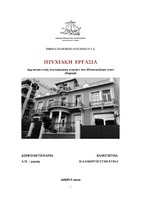| dc.contributor.advisor | Μαλικούτη, Σταματίνα | |
| dc.contributor.author | Δεσφινιώτη, Μαρία | |
| dc.date.accessioned | 2020-11-10T08:30:04Z | |
| dc.date.available | 2020-11-10T08:30:04Z | |
| dc.date.issued | 2020-10-22 | |
| dc.identifier.uri | http://okeanis.lib2.uniwa.gr/xmlui/handle/123456789/5470 | |
| dc.description.abstract | Η Ελλάδα , την περίοδο του Μεσοπολέμου , βρισκόταν σε οικονομοπολιτική αστάθεια και ταυτόχρονα σε μια ανάπτυξη στον τομέα της Αρχιτεκτονικής των κτιρίων και στην πολεοδομική της εξέλιξη. Εισήχθησαν διάφορα αρχιτεκτονικά ρεύματα από την Ευρώπη κατά σειρά , όπως η αρχιτεκτονική του Art Deco , ο Κλασικισμός , ο Εκλεκτικισμός και η Μοντέρνα Αρχιτεκτονική. Ο Πειραιάς κατά την εξεταζόμενη περίοδο , ξεχωρίζει για το λιμάνι του και στις αρχές του 20ου αιώνα πραγματοποιείται η σημαντικότερη επέκτασή του με την ρυμοτόμηση νέων συνοικισμών. Συγκεκριμένα , ο Πειραιάς αναπτύσσεται από το εμπόριο , τη ναυτιλία και την βιομηχανία , προσελκύοντας εργατικό δυναμικό και μαζί με την έλευση των προσφύγων , αυξάνεται ο αριθμός κατασκευής ιδιωτικών και δημόσιων κτιρίων. Τα ιδιωτικά και τα δημόσια κτίρια διακρίνονται κυρίως από τον Κλασικισμό , τον Εκλεκτικισμό και τον Μοντερνισμό με κύρια χαρακτηριστικά την συμμετρία , την τριμερή διαίρεση , τα πολυάριθμα διακοσμητικά στοιχεία , την διαφάνεια , τα κυλινδρικά σχήματα , τα δομικά υλικά κ.ά. με στόχο την καλή κατασκευαστική δομή τους , την σωστή λειτουργικότητα και την καθαρή μορφολογία τους. Η ποικιλία των αρχιτεκτονικών και οικοδομικών λεπτομερειών των κτιρίων είναι αξιοσημείωτη , καθώς δίνονταν μεγάλη έμφαση στην εξωτερική τους όψη. Η πλαισίωση των ανοιγμάτων , οι εξώστες , η μορφολογία των έρκερ , οι προεξοχές της στέγης , τα στηθαία των δωμάτων και άλλα πρόσθετα διακοσμητικά στοιχεία μας αποκαλύπτουν τις κύριες και ευδιάκριτες αρχιτεκτονικές λεπτομέρειες που κατασκευάζονταν την περίοδο του Μεσοπολέμου στον Πειραιά. | el |
| dc.format.extent | 85 | el |
| dc.language.iso | el | el |
| dc.publisher | Α.Ε.Ι. Πειραιά Τ.Τ. | el |
| dc.rights | Αναφορά Δημιουργού-Μη Εμπορική Χρήση-Όχι Παράγωγα Έργα 3.0 Ελλάδα | * |
| dc.rights.uri | http://creativecommons.org/licenses/by-nc-nd/3.0/gr/ | * |
| dc.subject | TPSH::Αρχιτεκτονική - Πολεοδομία::Πολεοδομία | el |
| dc.title | Αρχιτεκτονικές λεπτομέρειες των κτιρίων του μεσοπολέμου στον Πειραιά | el |
| dc.title.alternative | Architectural details of the mid-war in Piraeus - Greece | el |
| dc.type | Πτυχιακή εργασία | el |
| dc.contributor.committee | Κουρνιάτης, Νικόλαος | |
| dc.contributor.committee | Βαρελίδης, Γιώργος | |
| dc.contributor.department | Τμήμα Πολιτικών Μηχανικών Τ.Ε. | el |
| dc.contributor.faculty | Σχολή Τεχνολογικών Εφαρμογών | el |
| dc.subject.keyword | Μεσοπόλεμος | el |
| dc.subject.keyword | Αρχιτεκτονικές λεπτομέρειες | el |
| dc.subject.keyword | Πειραιάς | el |
| dc.subject.keyword | Μεσοπολεμικά κτίρια | el |
| dc.subject.keyword | Αρχιτεκτονική μελέτη | el |
| dc.subject.keyword | Αρχιτεκτονική | el |
| dc.description.abstracttranslated | During the Interwar period, Greece was in economic and political instability but, at the same time, there was development in the field of Architecture of buildings and urban development, as well. Several architectural movements from Europe were introduced such as Art Deco architecture, Classicism, Eclecticism and Modern Architecture. During that period, what is special in Piraeus is the port and its most important expansion is at the beginning of the 20th century with the creation of new settlements. Particularly, Piraeus developed because of commerce, maritime shipping and industry and after the arrival of the refugees, the rhythm of construction of private and public buildings increased. The private and public buildings were characterised mostly by Classicism , Eclecticism and Modernism their main features being symmetry , tripartite division , numerous decorative elements , transparency , cylindrical shapes , constructive materials etc. with the purpose of having a good contructional structure , proper functionality and clear morphology. The variety of the architectural and constructional details of the buildings is remarkable as great emphasis was placed on the external appearance. The framing of the openings , the terraces , the morphology of the erkers , the protrusion of the roof , the parapets of the rooms and other additional decorational elements reveal the main and prominent architectural details that existed in Piraeus during the Interwar period. | el |


